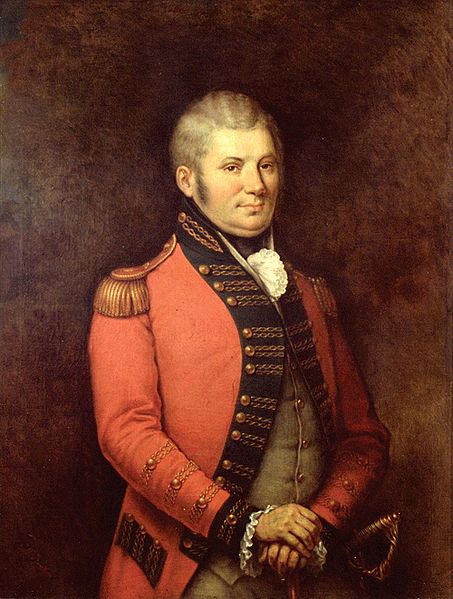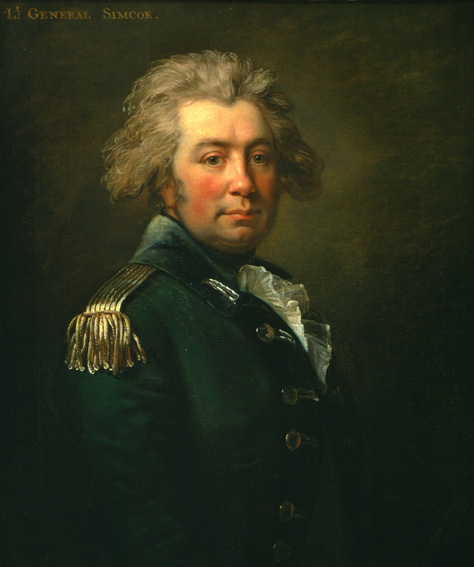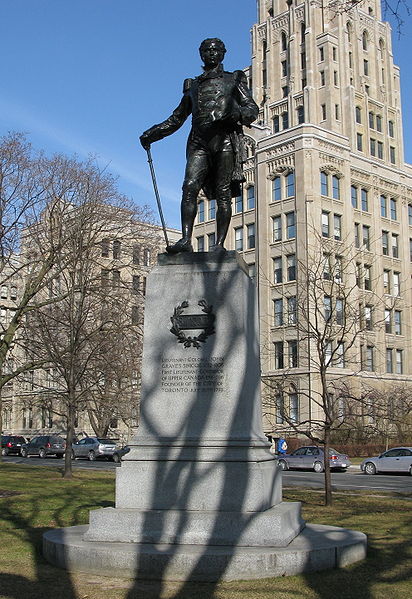<Back to Index>
- Economic Historian William James Ashley, 1860
- Poet José Joaquim Cesário Verde, 1855
- 1st Lieutenant Governor of Upper Canada and Founder of York John Graves Simcoe, 1752
PAGE SPONSOR



John Graves Simcoe (February 25, 1752 – October 26, 1806) was a British army officer and the first Lieutenant Governor of Upper Canada from 1791 - 1796. Then frontier, this was modern day southern Ontario and the watersheds of Georgian Bay and Lake Superior. He founded York (now Toronto) and was instrumental in introducing institutions such as the courts, trial by jury, English common law, freehold land tenure, and in abolishing slavery. He ended slavery in Upper Canada long before it was abolished in the British Empire as a whole - by 1810 there were no slaves in Upper Canada, but the Crown did not abolish slavery throughout the Empire until 1834.
John Graves Simcoe was the only surviving son of John and Katherine Simcoe; although his parents had four children, he was the only one to live past childhood. His father, a captain in the Royal Navy, commanded the 60 gun HMS Pembroke, with James Cook as his sailing master, during the 1758 siege of Louisbourg. When his father died of pneumonia a few months prior to the siege of Quebec, the family moved to his mother's parental home in Exeter. His paternal grandparents were William and Mary (née Hutchinson) Simcoe.
He was educated at Exeter Grammar School and Eton College. After a year at Merton College, Oxford, Simcoe was admitted to Lincoln's Inn, but then decided to follow the military career for which his father had intended him. He was initiated into Freemasonry in Union Lodge, Exeter, on November 2, 1773.
Simcoe's godfather was British admiral Samuel Graves. Simcoe married Graves' ward, Elizabeth Posthuma Gwillim, in 1782. The Simcoes had five daughters prior to their posting in Canada. Son Francis was born in 1791. Their Canadian born daughter, Katherine, died in infancy in York, Upper Canada. She is buried in the Victoria Square Memorial Park on Portland Avenue.
In 1770, Simcoe entered the British Army as an ensign in the 35th Regiment of Foot. His unit was dispatched to the Thirteen Colonies. Later he saw action in the American Revolutionary War, in the Siege of Boston. During the siege, he purchased a captaincy in the grenadier company of the 40th Regiment of Foot. With the 40th, he saw action in the New York, New Jersey and Philadelphia campaigns. Simcoe commanded the 40th at the Battle of Brandywine, where he was also wounded.
In 1777, Simcoe sought to form a Loyalist regiment of free blacks from Boston, but instead was offered the command of the Queen's Rangers, a well trained light infantry unit comprising 11 companies of 30 men, 1 grenadier and 1 hussar, and the rest light infantry. The Queen's Rangers saw extensive action during the Philadelphia campaign, including a successful surprise attack (planned and executed by Simcoe) at the Battle of Crooked Billet.
In 1778, Simcoe, during a foraging expedition opposed by rebel militia, commanded the attack on Judge William Hancock's house, killing 20 American rebels in their sleep and wounding 12 others. William Hancock was also killed, although he was not with the Americans. The massacre took place at night and with bayonets. On June 28 of that year, Simcoe and his Queen's Rangers took part in the Battle of Monmouth, in and near Freehold, New Jersey.
During the winter of 1779, Simcoe attempted to capture George Washington, but decided that his men would not shoot the future president. During that year, Armand Tuffin de La Rouërie captured Simcoe. Simcoe was released in 1781, and rejoined his unit in Virginia. He was involved in a skirmish near Williamsburg, and was at the Siege of Yorktown. He was invalided back to England in December of that year as a Lieutenant - Colonel.
Simcoe wrote a book on his experiences with the Rangers, titled A Journal of the Operations of the Queen's Rangers from the end of the year 1777 to the conclusion of the late American War, which was published in 1787.
The Province of Upper Canada was created under the Constitutional Act of 1791, within several years of the end of the American Revolutionary War. The area had been newly settled mostly by Anglo - American and other Loyalists from the Thirteen Colonies, as well as the Six Nations of the Iroquois, who had been allies during the war. The Crown had purchased land from the Mississaugas and other First Nations to give the Loyalists land grants in partial compensation for property lost in the United States, and to help them set up new communities.
Simcoe was appointed lieutenant governor and made plans to move to Upper Canada with his wife Elizabeth and daughter Sophia, leaving three daughters behind with their aunt. They left England in September and arrived on November 11. As this was too late in the year to make the trip to Upper Canada because of severe weather, the Simcoes spent the winter in Quebec City. The next spring they moved to Kingston and then Newark (now Niagara - on - the - Lake).
The Constitutional Act stipulated that the provincial government would consist of the Lieutenant - Governor, an appointed Executive Council and Legislative Council, and an elected Legislative Assembly. The first meeting of the nine member Legislative Council and sixteen member Legislative Assembly took place at Newark on September 17, 1792.
Simcoe's first priority was dealing with the effects of the Northwest Indian War, in which American Indians warred with the United States over encroachment in their territory west of the Appalachian Mountains. War broke out between Britain and France in 1793. Although the United States pledged neutrality, its sympathies were with France, an ally during the Revolution. Simcoe was instructed to avoid giving the US reason to mistrust Britain, but at the same time to keep the Native Americans on both sides of the border friendly to Britain.
Simcoe essentially denied the boundary defined in the Treaty of Paris (1783) on the grounds that the Americans had nullified the treaty. The British wanted the Indians to form a buffer state between the two countries. Tribes pushed into the area by the Iroquois and colonists allied with existing regional tribes. Together, groups of Ottawa, Ojibwa, Pottawatomi, and Huron; from eastern Illinois Country: the Miami, Wea, Kickapoo, Mascouten, and Piankashaw; and from the Ohio Country: the Delawares (Lenape), Shawnee, Mingo, and Wyandot, engaged in scattered warfare with the United States, trying to end Anglo - American encroachment. The conflicts were called the Northwest Indian War. The Indians asked the British for military support, which they initially refused. They did supply the Indians with weapons in 1794.
In February 1794, the Governor - in - Chief Lord Dorchester, anticipating that the Americans would honor their treaty with France, said that war was likely to break out between the United States and Great Britain before the year was out. His statement encouraged the Indians in their war. Dorchester ordered Simcoe to rally the Indians and arm British vessels on the Great Lakes. He also built Fort Miamis (in present day Maumee, Ohio) to supply Indians in the upcoming war. Simcoe expelled Americans from a settlement on southern Lake Erie which had threatened British control of the lake. George Washington denounced the "irregular and high - handed proceeding of Mr. Simcoe." While Dorchester planned for a defensive war, Simcoe urged London to declare war: "Upper Canada is not to be defended by remaining within the boundary line." Lord Dorchester was given an official reprimand for his strong speech against the Americans in 1794.
Simcoe realized that Newark made an unsuitable capital because it was on the United States border and subject to attack. He proposed moving the capital to a more defensible position in the middle of Upper Canada's southwestern peninsula between Lake Erie and Lake Huron. He named the new location London and renamed the river as the Thames in anticipation of the change. Lord Dorchester rejected this proposal, but he accepted Simcoe's second choice of Toronto. Simcoe moved the capital to Toronto in 1793, renaming the settlement York after Frederick, Duke of York, George III's second son.
Simcoe began construction of two main routes through Ontario to aid in the defense of Upper Canada; they would also help encourage settlement and trade throughout the province. Yonge Street, named after the Minister of War Sir George Yonge, was built north - south along the fur trade route between Lake Ontario and Lake Simcoe. Soldiers of the Queen's Rangers began cutting the road in August 1793, reaching Holland Landing in 1796. Another road, Dundas Street named for the Colonial Secretary Henry Dundas, was built east - west between London and York.
The Northwest Indian War stuttered to a stop after the United States defeated the Indians at the Battle of Fallen Timbers. They made peace under the Treaty of Greenville. While still at war with France, the British could not afford to antagonize the Americans. In the Jay Treaty of 1794, they agreed to abandon the frontier forts and to relocate on their side of the border defined in the Treaty of Paris (1783). Their plan for an Indian buffer state failed. After the British surrendered Fort Niagara in November 1796, they confronted the United States from Canada over the Niagara River.
In July 1796 poor health forced Simcoe to return to Britain. He was unable to return to Upper Canada and resigned his office in 1798.
He served briefly as the commander of British forces in Saint - Domingue (Haiti). There, in the spring of 1797, he defended the coastal town of Saint Marc but lost Mirebalais and the Central Plateau to the forces of Toussaint Louverture, leader of the slave revolt. This campaign signaled the end of the English attempt, in collaboration with the plantation owners, to restore slavery and other aspects of the ancien regime.
Simcoe was commissioned Colonel of the 81st Foot in 1798, but exchanged the position for the 22nd Foot less than six months later. He was also commander of the Western District in Britain. In 1806, he was appointed commander - in - chief of India (to succeed Charles Cornwallis, 1st Marquess Cornwallis, who had died shortly after arriving in India.) Simcoe died in Exeter before assuming the post. Gerard Lake, 1st Viscount Lake, was reappointed to replace Simcoe.
Simcoe was buried in Wolford Chapel on the Simcoe family estate near Honiton, Devon. The Ontario Heritage Foundation acquired title to the chapel in 1982.
- Act Against Slavery passed in 1793, leading to the abolition of slavery in Upper Canada by 1810. It was superseded by the Slavery Abolition Act 1833 that abolished slavery across the British Empire.
- Simcoe named London, Ontario and the River Thames in Upper Canada.
- He named Lake Simcoe in honor of his father.
- Simcoe named his summer home Castle Frank for his first son Francis Gwillim, who was preceded by eight daughters. (It is located in what is now named Cabbagetown, a neighbourhood in downtown Toronto.)
- The Ontario Heritage Foundation placed a plaque in Exeter's cathedral precinct to commemorate his life.
- Simcoe's regiment is still called the Queen's York Rangers, now an armored reconnaissance regiment of the Canadian Forces reserves.